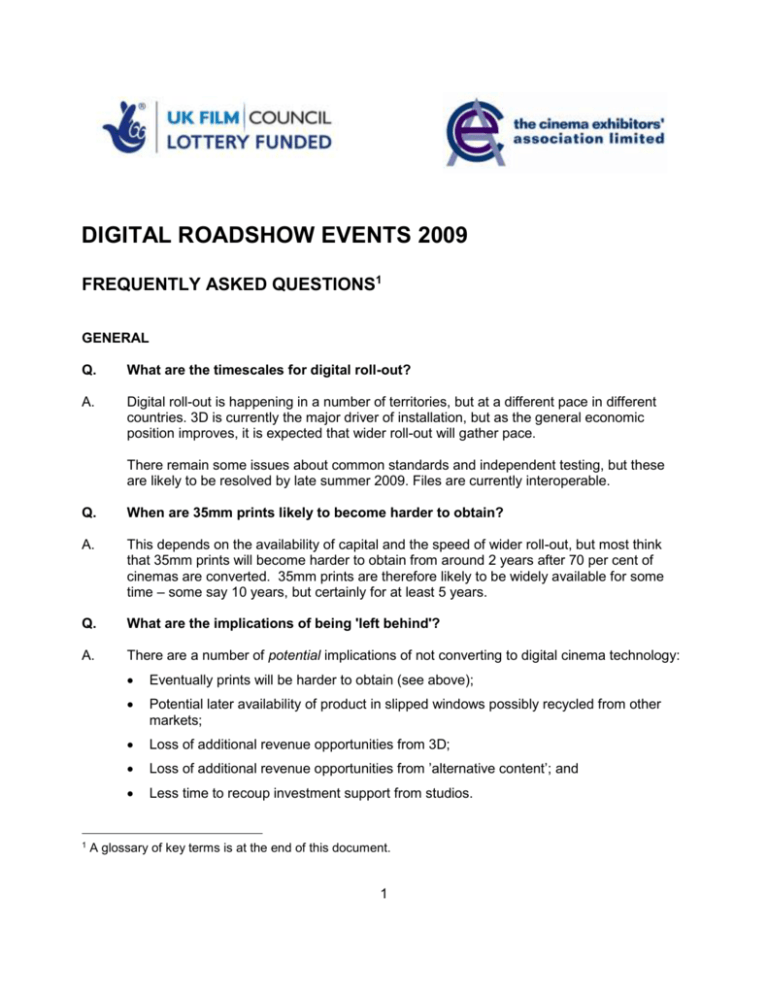Q and A briefing on digital cinema
advertisement

DIGITAL ROADSHOW EVENTS 2009 FREQUENTLY ASKED QUESTIONS1 GENERAL Q. What are the timescales for digital roll-out? A. Digital roll-out is happening in a number of territories, but at a different pace in different countries. 3D is currently the major driver of installation, but as the general economic position improves, it is expected that wider roll-out will gather pace. There remain some issues about common standards and independent testing, but these are likely to be resolved by late summer 2009. Files are currently interoperable. Q. When are 35mm prints likely to become harder to obtain? A. This depends on the availability of capital and the speed of wider roll-out, but most think that 35mm prints will become harder to obtain from around 2 years after 70 per cent of cinemas are converted. 35mm prints are therefore likely to be widely available for some time – some say 10 years, but certainly for at least 5 years. Q. What are the implications of being 'left behind'? A. There are a number of potential implications of not converting to digital cinema technology: 1 Eventually prints will be harder to obtain (see above); Potential later availability of product in slipped windows possibly recycled from other markets; Loss of additional revenue opportunities from 3D; Loss of additional revenue opportunities from ’alternative content’; and Less time to recoup investment support from studios. A glossary of key terms is at the end of this document. 1 FUNDING Q. Where do I get funding for equipment? A. There are currently a number of potential sources for funding: The Virtual Print Fee (VPF) model is a possibility – deploying entities (see glossary) such as Arts Alliance Media and XDC have negotiated VPFs from the distributors and have sourced long-term funding to pay for equipment. But the VPF deal requires a minimum amount of screens in a territory (probably 100 in the UK) and this has not been reached yet (there are no VPF-funded 2D digital screens currently in the UK); There is a possibility that studios may start to offer direct VPFs to exhibitors – Paramount has made this move in the US - thereby bypassing the deploying entities; There is no prospect of further national Government funding, though funding support may be available from local authorities or local companies/individuals. Q. What is the cost of projector? A. The cheapest model currently has a list price of £34,995 plus lens (£5,000 approx). In addition, a DCI-compliant (see glossary) cinema server costs around £15,000.This would include standard warranty of 1-2 years. (Extended warranties are expensive but so are spare parts.) The ‘street price’ however is lower – allow £50,000 to £60,000 to cover all the equipment, infrastructure and installation costs. Q. What are the maintenance costs and requirements of digital cinema equipment? A. These seem to be comparable to 35mm equipment – a good annual service by an approved equipment supplier. Digital cinema equipment needs planned maintenance with the change of consumables like fans, lamps etc. Where faults occur, there should be a service level agreement with the deploying entity or the system integrator (see glossary). Additional services will be offered by the market – particularly the ability to monitor remotely the equipment so that faults can be forecast and identified before they cause disruption to normal operations. Q. Will I get a warranty? A. All the equipment suppliers offer standard warranties – typically 1 or 2 years for parts and labour. They all offer extended warranty packages which can be purchased either at time of purchase or during the life of the standard warranty. The VPF deals are typically a 10 year contract and they include an annual maintenance/service charge to the exhibitor – the equipment is covered during the life of the service contract. Q. What are the financing costs? 2 A. The financing costs are as follows: Where the exhibitor purchases the equipment from their own funds, there are no financing costs. There may also be support from film distributors (see Paramount note earlier), with some perhaps limited operational cost savings which can be offset. There are tax relief benefits for capital equipment investment; If a deploying entity (a third party) is used, then they will advise the overall package cost. Q. What is the length of term of a typical contract? A. A deploying entity’s contract ceases when the equipment has been paid for - typically 7 years but certainly never more than 10 years. Current VPF deals have a term equal to rollout plus 10 years. A typical ‘self-finance’ contract is 3–5 years. Q. Do I need to reconfigure my projector box and what is the associated cost? A. Yes there is some system integration needed and the power supply system may need to be upgraded. But these are greatly reduced if the digital projector replaces the existing 35mm projector. There are also audio considerations. If the cinema is running a 5.1 digital sound system (Dolby or DTS) then all that is strictly necessary is a Digital to Analogue converter to convert the digital audio stream from the cinema server into an analogue stream for the existing digital sound processor. This typically costs around £1,500. If the cinema is however not running digital audio then it would be strongly recommended to upgrade the sound system to 5.1 digital sound to match the improvement in picture quality. Doing this from scratch would cost in the region of £10,000, but typically some or all of the installed equipment can be reused to reduce this cost. Q. What are the van delivery costs for files? A. The costs of delivery of digital files are currently similar to the cost of delivering a 35mm print, but are likely to reduce soon to half the 35mm print cost – and may well reduce further if satellite download becomes available. Q. What are the minimum guarantees? A. If self-funded then this is not relevant. If funded via a deploying entity then a minimum number of ‘turns’ need to be achieved each year – currently typically 11 - to achieve sufficient VPF payments to pay for the equipment over the life of the VPF contract. A single “turn” is achieved when a new film is booked to play at a cinema site – regardless of the number of times that film is screened or the number of screens that it is shown on at 3 that site. EQUIPMENT Q. How does equipment get installed? A. The deploying entity or system integrator will make a site survey to assess any building/electrical work, and any requirements around projector lamp size and lenses, audio integration, theatre system integration and server location. Q. Do I need specific broadband connections? A. Specific broadband connections are not required for normal system operation, but are highly recommended for remote diagnostics and system updates. Broadband is required if you choose to have the equipment monitored remotely and can be used for software updates and key delivery. Q. Will I need to run dual 35mm and digital for a time? A. A digital-only multiplex has been operating in the UK for over 12 months (the 10-screen Vue in Hull) and there are many other digital-only screens. But you may want to continue to retain the 35mm projector for a time depending on your programming and the physical practicality of doing so. Q. Where can I get the equipment? A. Equipment can be purchased directly from any of the traditional cinema equipment suppliers. The competitive nature of the equipment market has reduced costs dramatically and prices are not particularly sensitive to volume. Although it is possible to buy individual pieces of equipment, unless you are a large operator it may be better to work through a deploying entity or a buying group. A deploying entity or system integrator will arrange supply of all of the equipment. Q. What digital kit is out there and which works best to provide the widest range of possible programming? A. There are four projector manufacturers and at least eight server manufacturers. All digital equipment aims to meet the same DCI-specification2 as a minimum and there will soon be independent compliance testing laboratories in the US – but these will only confirm that the equipment meets the DCI specification. They will not recommend one model over 2 No equipment currently meets the DCI specification. There will be major upgrades, possibly over the next two years, to bring equipment up to DCI specifications. TI 2K "Series 1" projectors will never be DCI compliant, but will be grandfathered. Some studios require the "Gore fix" to these projectors in order to grandfather them. (The Gore fix does not make them DCI compliant.) 4 another. However, compliant equipment will be suited to task and can be configured to the library size you require. Each manufacturer has their own features designed in and which model suits which requirements best needs further individual investigation. Q. How quickly does new equipment become obsolete? A. The equipment will not become obsolete during its operating life – it may need upgrades to remain compliant, but will not become obsolete in the way for example of some consumer electronics. Manufacturers are expecting at least 10 years operation for the digital equipment. Equipment currently deployed under VPF agreements is compliant with the new DCI specifications, which are intended to be valid for at least the next 10-20 years. Q. Can you explain library storage of digital content? A. Library storage means that there is a central server with extended storage capacity. This is normally networked to the individual screen media blocks and can contain many more movies than the play-out servers – as many as 100 if you choose to pay for that amount of storage. The central server enables you to move content around projectors that have been networked together on sites. The rights issues around storing and re-using movies on such a server will need to be considered, as will the cost of such a storage facility. Library servers are intended for medium and large multiplex sites, but they can also be used where many film changes are needed in a short space of time (e.g. a film festival). The digital play-out server has internal storage – typically sufficient for 3 or 4 films. It can normally be upgraded for additional storage for 8 films. Q. Will consideration be given to authorising HD projectors? A. No. HDTV projectors and similar do not have either the correct colour space or internal ‘bit depth’ to reproduce DCI movies correctly. Low cost HD projectors are in addition subject to colour shifts and quality degradation over time. Moreover, HDTV projectors do not provide link encryption: the connection between 2k projectors and their servers is conversely secure and prevents the risk of copyright infringement by someone capturing the output of the server. DISTRIBUTION Q. Will 2nd/3rd run cinemas get digital films on release in the future? 5 A. Several studios have said that this will be the case, though the window will depend on the installed equipment. It is already a feature of the US market. Q. Will there be access to new films without blanket exclusivity to smaller/remote cinemas? A. Possibly – the easier it is for the film distributor to supply film to sites, the more likely it is that they will get access to new films earlier. Q. What will the distributor terms be? A. Although this remains under discussion, the impetus for digital cinema equipment comes from the distributors as they make the print cost savings – so it is likely that the terms will be the same for digital content as it is for 35mm content. Q. What will the availability be of digital films? A. The target for Hollywood is full availability. This is already a feature of the US market. Q. Do trailers and ads come in a digital format? A. This remains a developing market and depends on the advertising company and the film distributor. Certainly DCM and Pearl & Dean are very close to providing digital advertising. Many trailers are already available digitally and this will grow as more projectors are installed. Q. What will be the effect of digital cinema on screen advertising? A. It is still too early to tell what the impact/opportunity of digital is on screen advertising. For the remainder of 2009 the current sales packages i.e. weekly blocks are not likely to change. Once screen advertisers get a firmer picture of the size of the digital estates they will be able to ascertain the opportunities for advertisers. Q. If I go digital will I still get the full range of cinema advertising? A. Screen advertisers are currently in testing phases but yes that is the intention. Q. If I have a mix of digital and 35mm screens on one site, will I get ads in both formats? A. Yes. Q. What will be the effect on the gold spot - are the ads available in digital? A. Yes. Q. What is the effect of digital on trailers? 6 A. There should be no noticeable difference in the transition from 35mm to digital for the exhibitor in terms of availability of content. Currently nearly all trailers are available digitally from major distributors, and the delivery method is almost identical to print. You will receive a digital trailer via shipping, be it post or courier. The trailers can arrive on DVD, USB pen drive or added to the hard drive so you can load them when you receive your latest feature. The idea will be in the future that the trailers will be delivered to your server via other delivery methods (Internet or satellite). Managing your trailers is as simple as leaving it on your server or theatre management system. The average server can hold at least five features and if you kept four features, you would have enough room for well over 100 trailers. Creating trailer playlists, removing or adding trailers before features is a matter of selecting which trailers you need to play in what particular order. FLEXIBLE PROGRAMMING Q. Once I have digital equipment, can I run a film for a couple of days, wait a week or two, then play it again? A. This is technically possible, but depends on the relevant agreement with the distributor. Security keys required to play content can be time-limited, if required by the distributor. However, extension of such limits is fairly straightforward in practical terms. Q. Can I increase access e.g. for audiences with hearing impairments? A. Absolutely – the hard-of-hearing audio track will play out via your infra red unit or induction loop. Most digital features already come with subtitles for the hearing impaired – and this is easier to use as it does not require a second projector. Audio description should be widely available before the end of 2009. Q. What are the access features? A. The access feature allows subtitles to be projected at the same time as the feature without the need for a second projector – the subtitles are embedded on the digital master. DIGITAL OPERATION Q. How do I use servers and take advantage of remote programming? A. Assuming you have the right connections, remote programming of playlists is possible but the server must be loaded with the correct content. Q. Can you explain key delivery? 7 A. Electronic Keys are required to unlock encrypted material and allow it to be played. These are known as Key Delivery Messages or KDMs. They can be delivered by phone modem, e-mail or memory-stick. A KDM carries vital information for the exhibitor, such as the date and time window for screening, and the equipment (trusted device) on which such content is allowed to be played. Q. What are the staffing requirements of digital cinema operation? A. With some training, existing staff should be able to operate the digital equipment – although you may find your staffing requirements alter over time. Q. What is the energy usage? A. The energy usage of a digital projector with the associated equipment is roughly equivalent to the energy usage of a similar 35mm projector – probably a little less. However 3D adds to energy usage and shortens lamp lifetimes. The main consumer of energy in a digital projector is the lamp. Cinema projectors use Xenon lamps and the same technology is normally used for both film and digital projectors, generally in the range 3 – 7kW. Lamp power is mainly determined by screen size and required brightness. All cinemas should illuminate screens with the same ‘brightness’ so there is not a major difference between digital and film projectors as their optical efficiencies are similar. 3D technology is not as efficient as 2D as some of the light has to be filtered from each eye to create the stereoscopic difference in images. Lamp brightness is usually raised to compensate for the extra losses so extra power is required. The digital control electronics and storage technology is a relatively small share of the total power budget and not dependent on the type of movies shown (2D or 3D). Q. Can you explain audio integration? A. A Dolby processor needs an analogue input, but the digital equipment only provides a digital output – so an “audio integration” box is used – a Dolby DMA8+ or another market equivalent e.g. BPR. This may be supplied by manufacturers or supplied by the systems integrator as part of the system they offer. Q. What is the benefit of 4k over 2k digital projection? A. The major studios have discussed making premium productions in 4k (ie 4096 x 2160 pixels). Better resolution provides better screen image, but few exhibitors seem currently willing to pay for the improvement. According to DCI specifications, all 2k systems must be able to play 4k content and vice versa. Q. Will I need to change my publicity/marketing? 8 A. There is no pressing need to, but it might be advantageous to promote the digital benefits – sharper, clearer picture that doesn’t degrade over time, more flexible programming etc. Certainly those who have invested in 3D technology (see below) have wished to emphasise this in their marketing. DIGITAL 3D CINEMA Q. What are the different 3D system requirements? A. There are a number of proprietary systems available, each with different requirements: Real D - silver screen, Z screen modulator, low-cost disposable passive polarised glasses; masterImage – silver screen, rotating filter wheel, low-cost disposable passive polarised glasses; Dolby - colour wheel modification to projectors, reusable higher cost, passive glasses; XpanD - infra red modulator, higher cost, reusable active glasses; Sony - 3D lens assembly and firmware upgrade, silver screen, low cost passive glasses. Q. What are the options and practicalities around 3D glasses? A. The issues around 3D glasses are as follows: Passive polarised glasses are potentially throw-away, but they need storage and logistics management. Dolby Glasses need recycling but may have a lower overall usage cost. XpanD Glasses need recycling but may have a lower overall usage cost. Q. How much do 3D projectors cost? A. Existing digital projectors might be equipped with a conversion kit, depending on the system chosen. However not all digital projectors are capable of being upgraded, so this needs to be borne in mind if it is the intention to run 3D in the future. Small projectors that are suitable for 2D may not fill your screen for 3D – 3D is very light “hungry”. Costs for the additional equipment necessary to show 3D vary. The leading systems in the UK each have different charging systems: Dolby – uses the existing screen if it has high gain surface, one-off cost of approx £15,000; reusable glasses costs of £15/pair Real D and Sony – require a silver screen (£60 per square metre) in additional to a capital cost of around $10,000 (£7,000), and a seat revenue is payable – approx 30p per ticket for 3D performances through the life of the system. (However Real D has a 9 number of different pricing arrangements and not all of them require a share of ticket revenue). masterImage - requires a silver screen (£60 per square metre), system is purchased outright for a capital cost of around £21,000, or can be purchased over five years for seat revenue – approx 25p per ticket for 3D performances and small down payment. Q. Do I pay for 3D glasses to get washed for reuse or is there a disposable option? A. The answer here again varies according to the 3D system involved: Dolby and XpanD – in both cases, glasses can be washed by the exhibitor in a standard dishwasher (below 50°). In some territories customers are provided with wipes to clean the glasses themselves instead; Real D and masterImage – low cost glasses here are intended for single use, disposable and currently issued free by the film distributor. The above position is likely to change in the future. Q. Do I need to install a silver screen and what is the cost? A. A silver screen is required for the Real-D, masterImage and Sony systems. The cost is approx. £60 per square metre for the screen and transport and fitting. Even where other systems are being used, 3D cinema is very light “hungry” and a higher gain screen (for example with a gain rating of 1.8) may be required or advisable. ALTERNATIVE CONTENT Q. Can I take advantage of live satellite transmission? A. Yes, with supplementary equipment and a satellite dish. Q. What is the difference between a DVD and a digital file? A. A DVD is a data storage device and can carry a programme or a file. Q. Can I make use of the DSN to screen alternative content? A. Yes, if the system has the supplementary equipment mentioned above. 10 GLOSSARY Alternative content Digital cinema equipment allows cinema sites to show not only traditional feature films, but also socalled ‘alternative content’ – live or near live music, cultural and sporting events, and potentially also activities such as live computer gaming. The experience of exhibitors so far is that these screenings can be extremely popular, with audiences willing to pay a significant premium on ticket prices for the experience. Deploying Entity A deploying entity is a company that has VPF arrangements with one or more film studios. The deploying entity negotiates such agreements with the studios, arranges finance, purchases and arranges installation of the equipment, as well as providing ongoing technical support. The exhibitor pays a contribution to the deploying entity for these services. The distributor pays a VPF. A deploying entity may well use a systems integrator (see below) for the installation and technical support of the digital equipment. Current deploying entity companies include: Arts Alliance Media – for Europe XDC – for Europe Ymagis – for Europe Cinedigm – for USA Kodak – for USA GDC – for China Digital Cinema Initiatives - DCI Digital Cinema Initiatives – DCI – is a joint venture of the six major studios in the US. DCI has published a system specification for digital cinema, covering encryption, key management and logging as well as minimum specifications for the projectors. Much of the specification codifies work already ongoing in the Society of Motion Picture and Television Engineers (SMPTE), but is important in that it has establishing a framework for the distribution and security of first-release film content to which the studios are signed up. Key Delivery Messages – KDMs Key Delivery Messages – KDMs – are the way in which encrypted Digital Cinema Packages (DCPs) are decompressed and decoded on the digital cinema server. In short, the KDM ‘unlocks’ the film on the server for the duration of time that the cinema has contracted to screen that film. 11 Systems Integrator A systems integrator is a company that provides services directly to the exhibitor – either by way of direct sales of equipment and/or services, or working for the deploying entity. Services can include equipment selection, delivery, infrastructure works, installation and integration with existing sound and automation equipment. Most system integrators are traditional 35mm companies that have migrated into the digital world. Current system integrator companies include: Arts Alliance Media – for Europe Bell Theatre Services – for UK Sound Associates - for UK FTT - for Germany KCS - for Spain Cinetech - for Ireland and others. Virtual Print Fee - VPF The Virtual Print Fee (VPF) model is one way of financing the conversion of exhibition to digital projection. In most cases to date, the model has worked where a third party intermediary has paid for equipment upfront and recouped the cost over time from the distributors (who pay the majority) and exhibitors. The VPF is the fee paid by the distributor to the intermediary, reflecting the savings made in producing and transporting digital files rather than 35mm prints. 12 CONTACT DETAILS FOR KEY SUPPLIERS LISTED Deploying entity companies Arts Alliance Media Cinedigm GDC Kodak Digital Cinema XDC Ymagis www.artsalliancemedia.com www.cinedigm.com www.gdc-tech.com http://motion.kodak.com/GB/en/motion/index.htm www.xdcinema.com www.ymagis.com System integrators Arts Alliance Media Bell Theatre Services Cinetech FTT KCS Omnex Sound Associates www.artsalliancemedia.com www.bell-theatre.com www.cinetechonline.com www.ftt-online.de/eng www.kcsdigital.com www.omnexprofilm.co.uk www.soundassociates.co.uk Digital projector manufacturers Barco Christie Digital Systems NEC Sony www.barco.com/ www.christiedigital.co.uk/emeaen/ www.nec.com/eu/index.html http://pro.sony.com/bbsc/ssr/mkt-digitalcinema/ Digital server manufacturers Dolby Doremi Labs DTS Digital Cinema GDC Technology Ltd Kodak Digital Cinema Qube Cinema Sony USL Inc. www.dolby.com/professional/motion_picture/solutions_d3ddc.html www.doremicinema.com www.dtsdcinema.com www.gdc-tech.com http://motion.kodak.com/GB/en/motion/index.htm www.qubecinema.com/ http://pro.sony.com/bbsc/ssr/mkt-digitalcinema/ www.uslinc.com/main.html Digital 3D System suppliers Dolby masterImage RealD Sony XpanD www.dolby.com/professional/motion_picture/solutions_d3ddc.html www.masterimage3d.com www.reald.com http://pro.sony.com/bbsc/ssr/mkt-digitalcinema/ www.xpandcinema.com 13 Screen advertising agencies Digital Cinema Media Pearl and Dean www.dcm.co.uk www.pearlanddean.com Trailers and Point of Sale Deluxe Film Services MPD www.bydeluxe.com www.mpdlimited.co.uk 14



![[Lecture 4] from attractions to narrative integration 2012 for wiki](http://s2.studylib.net/store/data/005411128_1-612acd924ade64473e514356e531fdfd-300x300.png)

